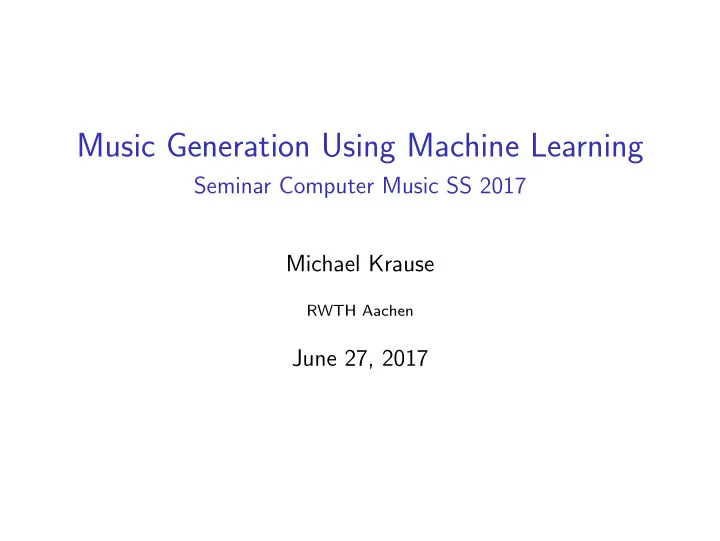

Music Generation Using Machine Learning Seminar Computer Music SS 2017 Michael Krause RWTH Aachen June 27, 2017
The problem Can a computer create new music? ◮ Applications: assisted composition, video games, music analysis ◮ Two broad steps: Composing and creating audio signal ◮ Composing: melody, rhythm, structure, instrumentation... 2 / 25
Outline of the talk History Current approaches Unit selection using deep learning Evolutionary multi-objective optimization Conclusion 3 / 25
History 4 / 25
History: AI research and music generation ◮ General trend in AI: move from symbolic methods (GOFAI) to machine learning / data-based approaches ◮ Formal grammar approach ◮ Create structure through (stochastic) rewriting rules ◮ Hand-made or learned from data ◮ Terminal symbols can be notes/chords/measures... ◮ Markov Chains ◮ States: notes or measures ◮ Transitions: probabilities learned from examples or hand-made ◮ No higher level structure ◮ More recently: Machine Learning (e.g. neural networks) 5 / 25
Current approaches 6 / 25
Now: Two approaches for melody generation ◮ Melody: essential for most music ◮ Competing approaches: ◮ Bretan et al. (2016): uses deep learning ◮ de Le´ on et al. (2016): evolutionary algorithm with machine learning based fitness functions 7 / 25
Current approaches: Unit selection using deep learning 8 / 25
Setup ◮ Given: > 4000 melodies (in particular Jazz) ◮ Divide into units (1, 2 or 4 measures of melody) ◮ Create new melodies by concatenating units ◮ Connected units should ◮ share semantic similarity ◮ have pleasant transitions → Train two neural nets to encode these properties 9 / 25
Neural nets: Basic example Output Hidden layer Input 10 / 25
Neural net for semantic similarity Semantic vector Hidden layer Hidden layer Representation (lower dim) Input unit (high dim) Idea: train semantic vectors for consecutive units to be similar 11 / 25
Neural net for note transitions Next Note Cell state Layers Note 12 / 25
Melody generation: Ranking and concatenation ◮ Start with some measures of music given ◮ Rank all units given the previous measures ◮ Firstly: according to similarity ◮ Secondly: according to note transitions ◮ Concatenate measures with highest ranked unit and repeat (listen to audio example) 13 / 25
Current approaches: Evolutionary multi-objective optimization 14 / 25
Evolutionary optimization overview ◮ Optimization problem in general: candidate solutions and objective function ◮ Here: candidates set is “population”, objective is high “fitness” ◮ The phenotype (appearance) of a candidate may be different from its genotype (encoding/representation) ◮ Initial candidates are repeatedly evolved through ◮ Variation: modify candidates through crossover and mutation ◮ Selection: retain only candidates with good objective value 15 / 25
Evolutionary multi-objective optimization ◮ Challenges for evolutionary approach to music ◮ How to encode genotype? ◮ How to generate candidates? ◮ How to evaluate fitness? User interaction? ◮ In the present paper ◮ Melodies are trees ◮ Initial melodies are generated randomly ◮ Fitness consists of multiple measures, partly learned from existing melodies of a given style 16 / 25
Melodies as trees (Figure 1 from the paper) 17 / 25
Crossover and mutation ◮ “Fittest” candidates are admitted to crossover and mutation ◮ Mutation: With small probability a node is randomly replaced ◮ Crossover: Nodes swapped between pairs of candidates (figure) (Figure 2 from the paper) 18 / 25
Fitness functions ◮ 12 separate ones used ◮ Function parameters based on body of melodies in a style ◮ Examples: ◮ Global descriptors (number of notes, most repeated interval, average pitch and deviation etc.) ◮ Language model (probability of note after previous 4 notes) ◮ Music analysis (e.g. number of segments in melody) ◮ Candidate A pareto-optimal : for all candidates B with higher fitness than A in some function, B must have lower fitness than A in another function 19 / 25
Results (fitness trained for different styles) (listen to audio example) 20 / 25
Results (fitness trained for different styles) (listen to audio example) 21 / 25
Conclusion 22 / 25
Conclusion Take-home concepts: ◮ Move from symbolic to machine learning methods ◮ Unit selection using neural networks ◮ Melody tree as result of evolutionary optimization Possible further work: ◮ Variety vs. higher level structure ◮ Extend approaches to generate harmonization ◮ Quality measures? 23 / 25
Papers Mason Bretan, Gil Weinberg, and Larry Heck. A Unit Selection Methodology for Music Generation Using Deep Neural Networks. arXiv:1612.03789 [cs.SD], 2016. Pedro J. Ponce de Le´ on, Jos´ e M. I˜ nesta, Jorge Calvo-Zaragoza, and David Rizo. Data-based melody generation through multi-objective evolutionary computation. Journal of Mathematics and Music , 10(2):173–192, 2016. Jose David Fern´ andez and Francisco Vico. AI Methods in Algorithmic Composition: A Comprehensive Survey. Journal Of Artificial Intelligence Research , 48:513–582, 2013. 24 / 25
More sources ◮ Example music composed using the DNN approach ◮ Example music composed using the evolutionary approach I have arranged some of these in MuseScore here, so they can be heard 25 / 25
Recommend
More recommend